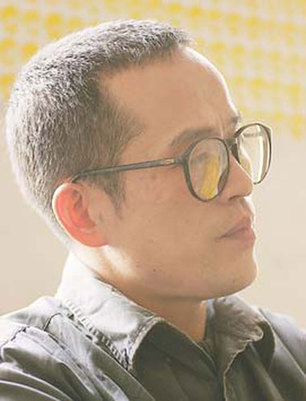 |
|
The mellow yellow "Dual Visual Angel" by Shanghai pop acrylics painter Pu Jie represents two views of the same person or thing, showing different aspects; it also refers to juxtaposition of ideas and historical periods. |
Pop acrylics painter Pu Jie is very mellow yellow.Yellow, in fact, is his signature color. Yellow was the color of imperial China, a color of warmth and strength, a favorite vivid color of cartoonists, the color of the so-called "yellow" races, the color of yellow journalism, and so on.
An exhibition of 30 predominantly yellow acrylics, featuring the Shanghai-native artist's "dual visual angle," is underway at the Today Art Museum in Beijing through September 30.
Dual refers sometimes to his depiction of "double" images, or two views of the same person or thing, showing different aspects; it also refers to juxtaposition of ideas and historical periods.
"I don't know whether I understand pop art or not. I don't know of any artist before me who has adopted my meaningful 'Dual Visual Angle'," claims the 50-year-old artist.
Pu graduated from Shanghai Normal University in 1986. Although he is widely known in the art community, he isn't a big socializer at art events.
He is especially fond of the color yellow, historically associated with China's royalty and power. He calls his extensive use of yellow his "signature."
Pu is more interested in the contemporary concepts of yellow, however, and notes that Chinese people refer to off-color jokes or movies as "yellow." It also conveys the sense of trash.
 |
|
Pu Jie |
For example, he colors a city lemon yellow and colors young female consumers yellow as well to signify shallow commercial culture.
He uses short black lines to outline his characters, emphasizing energy and vitality, but also brevity, uncertainty and emptiness.
His pop art "Dual Vision" suggests back and forth, compare and contrast, but Pu arranges his paintings in a narrative.
"I like (Andy) Warhol and (Roy) Lichtenstein because of the strong modern fusion in their works, while I prefer the line depictions in traditional Chinese paintings," Pu says. "The use of line is an important aspect of Chinese art."
Pu focuses on "present life and present people."
People and their cities strive toward material benefits but still wish for utopian societies and ideals, he says. Pu's works capture this tension.
"I focus on social phenomena and the cultural forms of modern China," says Pu. "Chinese contemporary art would lose its primitive power if it abandons these elements."
"What is modern art? There are many definitions but in the spirit of post-modernism, it captures the changes in modern society and culture," Pu says. "The backbone of Chinese contemporary art is the re-pondering of Chinese culture with a critical attitude."
For Pu, the "Dual Visual Angle" is a partial overlapping of past and present, East and West, A and B.
He applies his angle to the "cultural revolution" (1966-76), which figures prominently in his childhood memories.
"From my primary school days, I was educated in revolutionary ideas. In university I studied market economy with Chinese characteristics. What I experienced are two different eras.
"'Dual Visual Angle' is more related to my life experience than it is a symbol. The collision of two periods forced me to see that I am living in a changing environment," he says.
Some paintings feature political figures or major events and Pu uses them to represent his ideas about politics.
"Perhaps like some Chinese intellectuals, I can't change the 'bad habit' of being doctrinaire," he says.
(Shanghai Daily September 2, 2009)